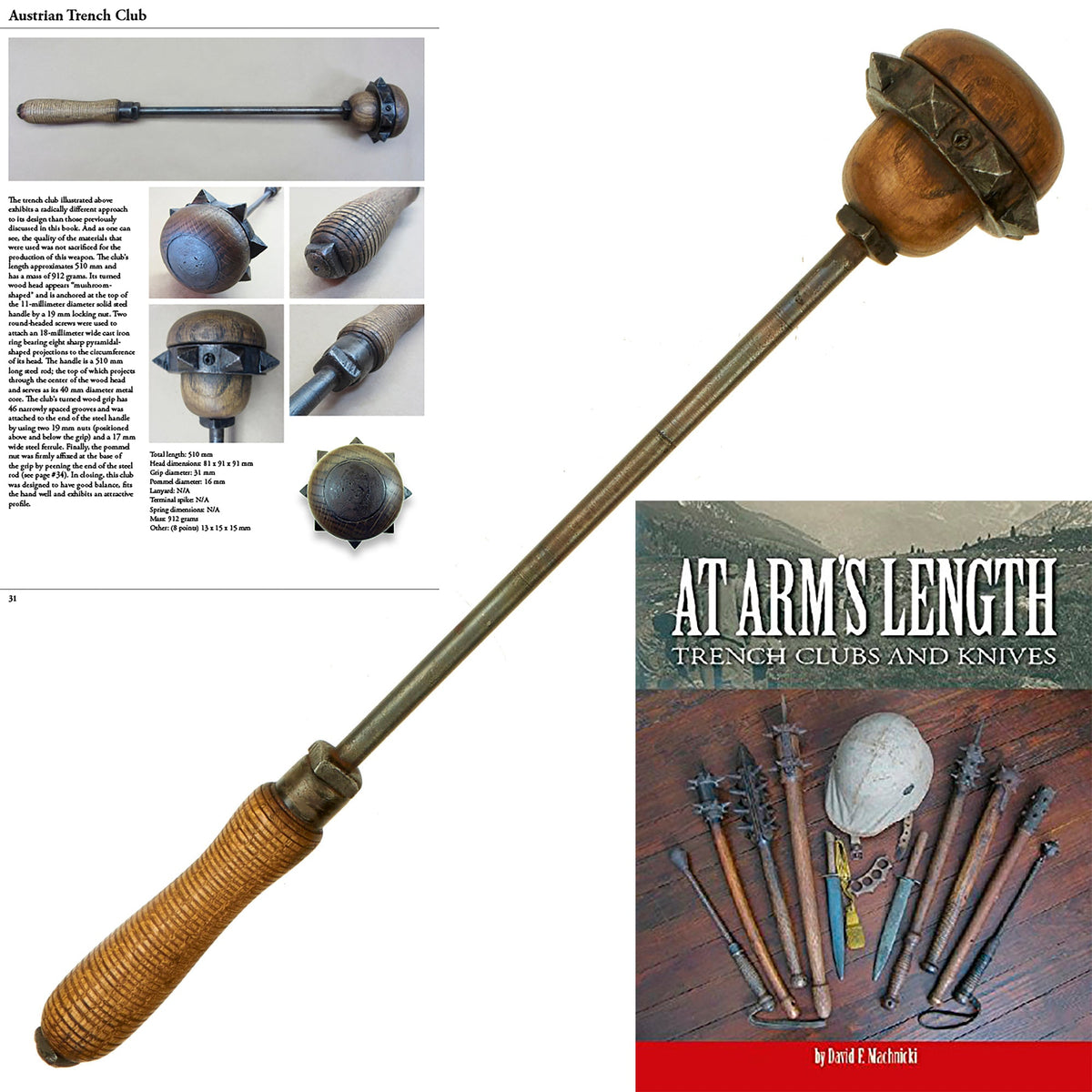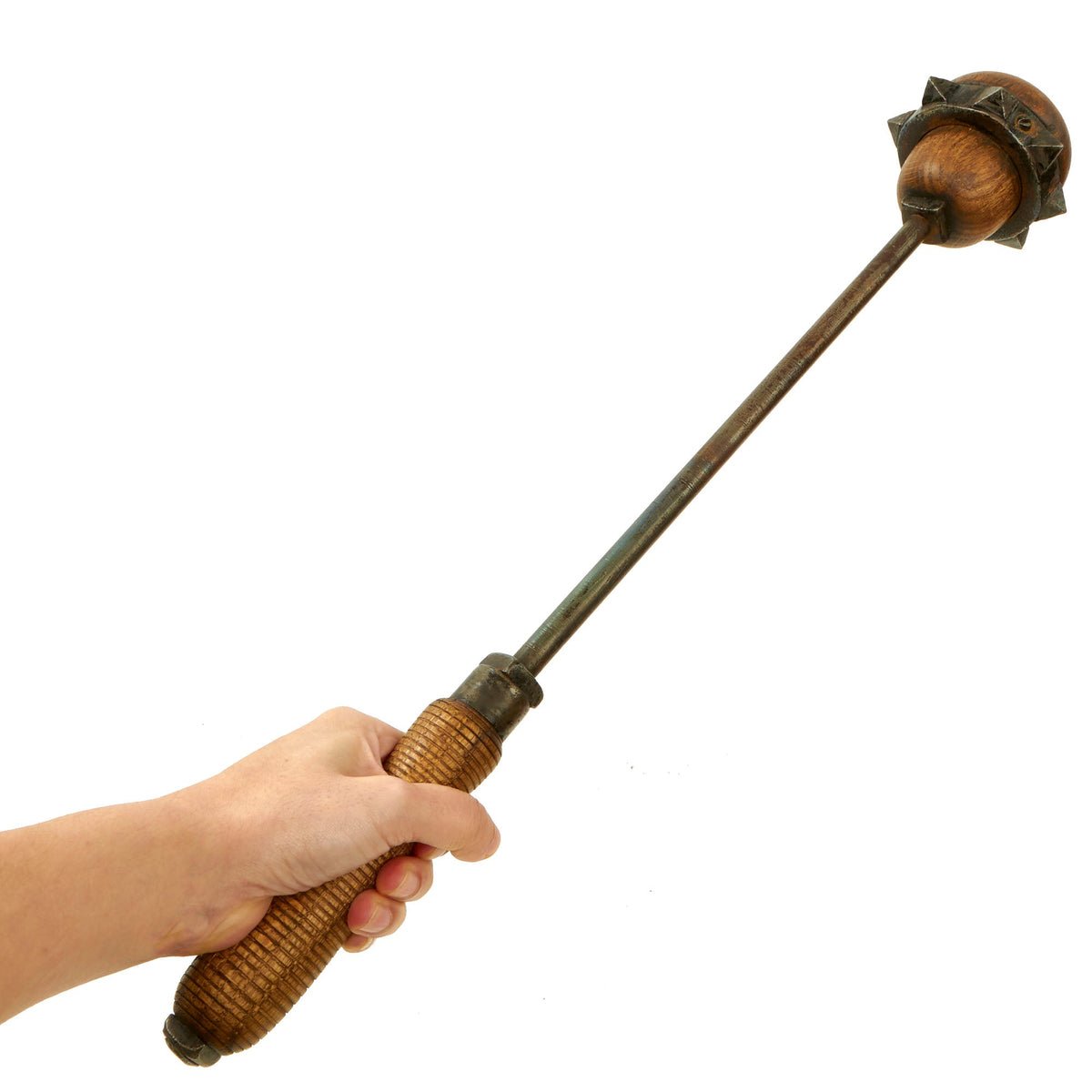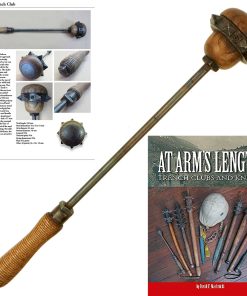Original Austro-Hungarian WWI Mushroom Shaped Trench Raiding Club – Featured in Book At Arm’s Length Page 31 Original Items
$ 2.495,00 $ 623,75
Original Item: One-of-a-kind. Purchased directly from David F. Machnicki, the author of At Arm’s Length Trench Clubs and Knives (Vol. 1), where this very club is featured on page 31! Please note that the attached page image from the book is copyrighted material and the use of the page is done by permission of the author. A printed copy of the page will accompany the purchase of this club.
This trench club exhibits a radically different approach to its design than most encountered on the collectors market today. And as one can see, the quality of the materials that were used was not sacrificed for the production of this weapon. The club’s length approximates 510 mm and has a mass of 912 grams. Its turned wood head appears “mushroom- shaped’ and is anchored at the top of the 11-millimeter diameter solid steel handle by a 19 mm locking nut. Two round-headed screws were used to attach an 18-millimeter wide cast iron ring bearing eight sharp pyramidal-shaped projections to the circumference of its head. The handle is a 510 mm long steel rod; the top of which projects through the center of the wood head and serves as its 40 mm diameter metal core. The club’s turned wood grip has 46 narrowly spaced grooves and was attached to the end of the steel handle by using two 19 mm nuts (positioned above and below the grip) and a 17 mm wide steel ferrule. Finally, the pommel nut was firmly affixed at the base of the grip by peening the end of the steel rod. In closing, this club was designed to have good balance, fits the hand well and exhibits an attractive profile.
Total length: 523 mm
Head dimensions: 81 x 91 x 91 mm
Grip diameter: 31 mm
Pommel diameter: 16 mm
Lanyard: N/A
Terminal spike: N/A
Spring dimensions: N/A
Mass 912 grams
Other: (8 Points) 13 x 13 x 15 mm
Trench raiding clubs were homemade melee weapons used by both the Allies and the Central Powers during World War I. Clubs were used during nighttime trench raiding expeditions as a quiet and effective way of killing or wounding enemy soldiers. The clubs were usually made out of wood. It was common practice to fix a metal object at the striking end (e.g. an empty Mills bomb) in order to maximize the injury inflicted. Another common design comprised a simple stave with the end drilled out and a lead weight inserted, with rows of large hobnails hammered in around its circumference. Most designs had some form of cord or leather strap at the end to wrap around the user’s wrist. Bosnian soldiers serving in the Austro-Hungarian army were fond of using maces. They were also used by officers to finish enemy soldiers wounded by poison gas attacks.
Trench clubs were manufactured in bulk by units based behind the lines. Typically, regimental carpenters and metal workers would make large numbers of the same design of club. They were generally used along with other “quiet” weapons such as trench knives, entrenching tools, bayonets, hatchets and pickaxe handles – backed up with revolvers and hand grenades.
Fast Shipping with Professional Packaging
Thanks to our longstanding association with UPS FedEx DHL, and other major international carriers, we are able to provide a range of shipping options. Our warehouse staff is expertly trained and will wrap your products according to our exact and precise specifications. Prior to shipping, your goods will be thoroughly examined and securely secured. We ship to thousands clients each day across multiple countries. This shows how we're dedicated to be the largest retailer on the internet. Warehouses and distribution centres can be located throughout Europe as well as the USA.
Note: Orders with more than one item will be assigned a processing date depending on the item.
Before shipping before shipping, we'll conduct a thorough inspection of the items you have ordered. Today, the majority of orders will be delivered within 48 hours. The delivery time will be between 3-7 days.
Returns
The stock is dynamic and we cannot completely manage it because multiple stakeholders are involved, including our factory and warehouse. So the actual stock may alter at any time. It's possible that you may not receive your order once the order has been made.
Our policy is valid for a period of 30 days. If you don't receive the product within 30 days, we are not able to issue a refund or an exchange.
You can only return an item if it is unused and in the same state as the day you received it. You must have the item in its original packaging.
Related products
Uncategorized
Uncategorized
Uncategorized
Uncategorized
Uncategorized
Uncategorized
Uncategorized
Band of Brothers ORIGINAL GERMAN WWII Le. F.H. 18 10.5cm ARTILLERY PIECE Original Items
Uncategorized
Uncategorized
Uncategorized
Uncategorized
Armoured Fighting Vehicles of the World: AFVs of World War One (Hardcover Book) New Made Items
Uncategorized
Uncategorized
Uncategorized
Uncategorized
Uncategorized












































































